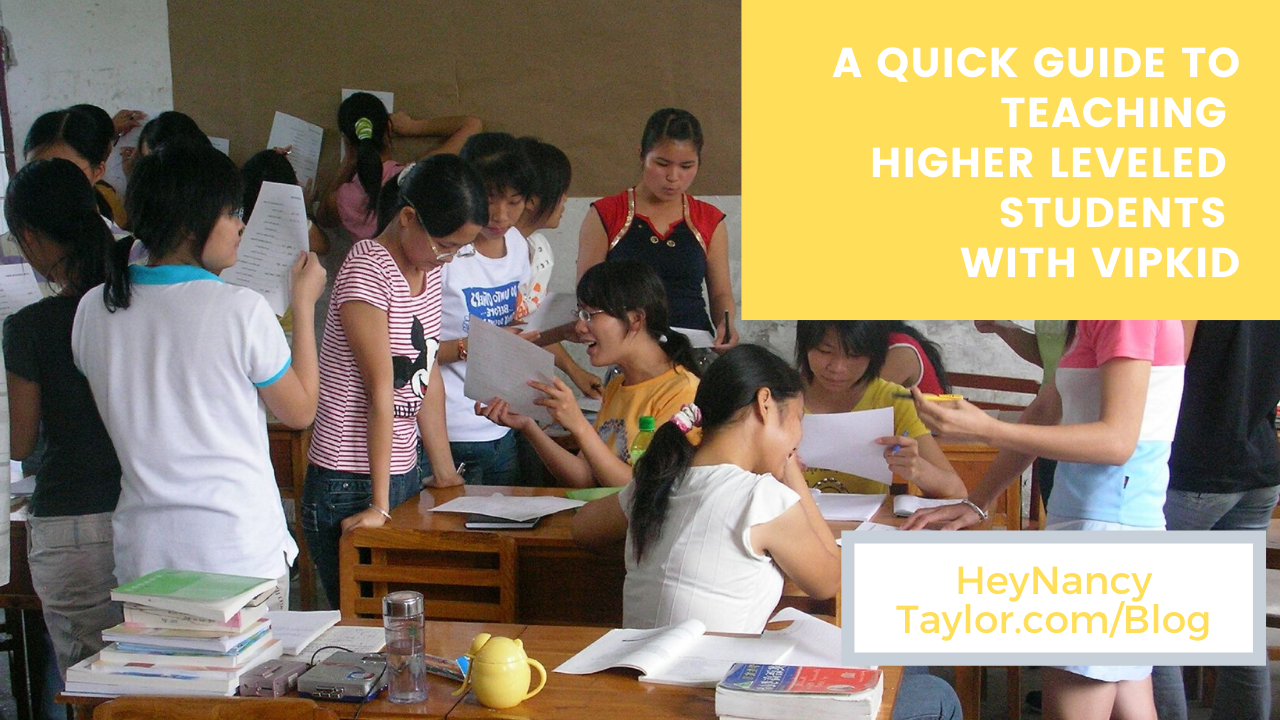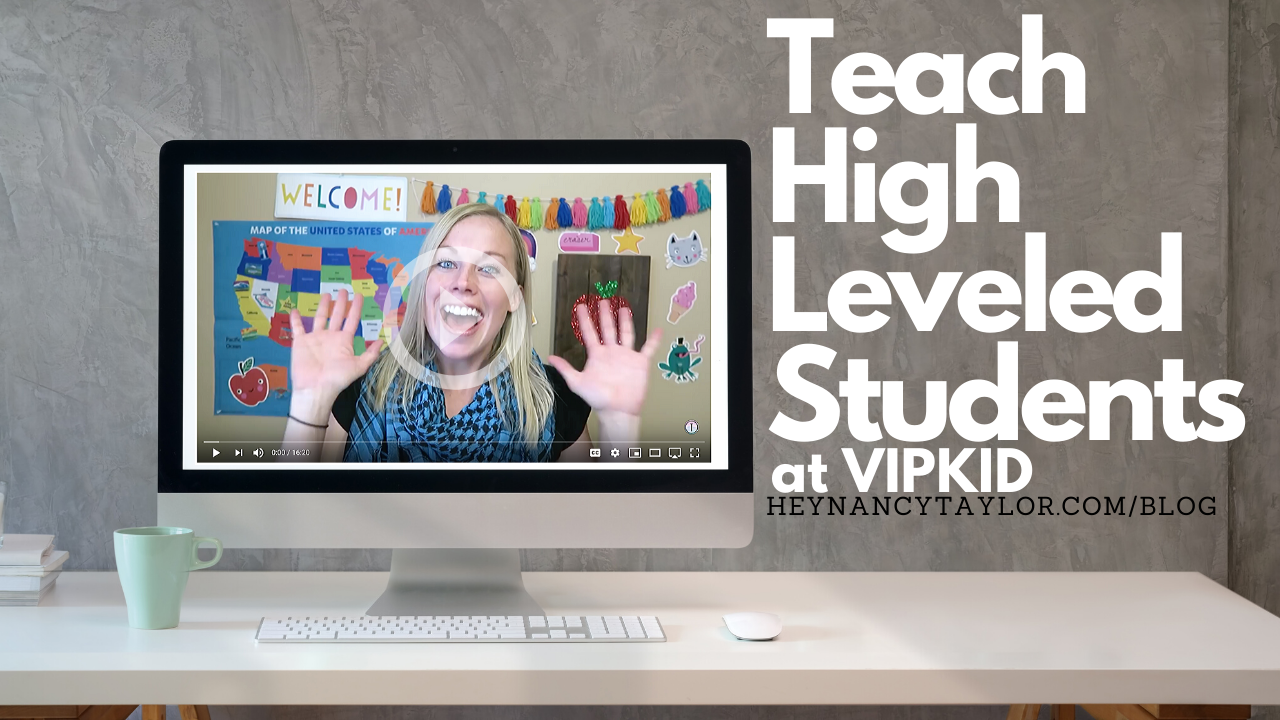A Quick Guide to Teaching Higher Level Students with VIPKID

Hi I'm Stephanie (insert monotone echo "Hello Stephanie") and I have a confession.... I have taught with VIPKID for over two and a half years and have never taught any of the higher levels. What?!? Here's what happened, I love teaching the little ones and after the first month or two, I never had a problem with bookings. However, I must admit, I am intrigued by the depth of the content and the lure of teaching a more independent mind. So, I decided to get my own certifications for Levels 4, 5, and 6. Now that I have them, I had three questions
1-Who am I teaching?
2- What am I teaching?
3- How do I teach it?
I took some notes from my course classes and found lots of great online content to answer my questions, including this video full of great do's and don'ts from Miss Nancy Taylor herself...
I've compiled my "research" (chicken scratches stained with Mac & Cheese) here for you so that you have one quick guide for teaching higher leveled students with VIPKID.
Who are you teaching?
"Level 5 students are higher level students who can read and understand more complex texts and make comparisons. These students have English classes they take outside of VIPKid.... The class feels less like an ESL class and more like a "normal class." -From the introduction of the Level 5 Certification Course with VIPKID.
These students have a great foundation for language. They have a deep vocabulary bank to draw from and know the basics of sentence structure. They will be able to carry on a conversation about their day to day (get ready for lots of Frozen 2 spoilers... haha). And they can use judgement to make a decision. This class will be less instruction on English language and more about the actual content and allowing the students to have conversations.
There are no specific ages for these kids because their level placement is all about their skill and ability with using English. This will be different for each child based on their experience and exposure to English lessons.

What are you teaching?
Topics include history, literature, and basic science. They have most of the English "rules" down. Phonics and spelling mostly focus on exceptions to rules. Something to remember for any level is to always meet the objectives. You might not get the exact phrase out of the student for one slide. Ask yourself "Did they meet the objective?" That's your measure of success and should be your guiding teaching principle. There will be vocabulary, grammar, math or phonics for each lesson. Look these over before class, prepare prop, think of extension questions and check for understanding throughout the lesson.
How do you teach?
Do you remember Bloom's taxonomy from your education 101 class? Just in case you don't, here is a quick refresh:

It is a map to the way we think and the levels of learning. The lower levels are more about fundamental learning principals. You use these a lot when teaching the lower leveled students. In the higher leveled lessons there will be more opportunities for content extension and critical thinking skills. You will use more of the Analysis, Evaluation, and Creation as you teach these classes.

Practice:
Here are some basic practices to use in the higher levels:
- Pacing, Timing, Patience - The general rule for teaching is about 1 minute per slide. This can be tricky as the students in these levels are being asked to perform a higher level of thinking and vocalize it in another language. Give them time to think, answer, and self correct. This will give them confidence as they get more familiar with the content. As you might guess, new material will take longer and review material should take less time. Adjust your time for each student and come to class prepared and organized.
- Delivering the Content - This is where your own creativity and personality will guide the course of the lesson. Integrate a content-related reward, sing a song to learn the sentence pattern, switch roles (have them teach you), or have a competition. Utilize a timer. TICK TOCK, times running out! Move props (or yourself) around the screen. Don't be boring! These are all fun ways to give them the content beyond just reading the slide. An excellent teaching strategy to use for content delivery is MODELING. Show the student the expectations, practice and then let them answer independently.
- Build Student Rapport - Students need to know you care. DO NOT just jump into the lesson. Be friendly and have a short conversation. Part of the great thing with this job is the interaction. Think about all the ways they could learn and practice English; read a book, watch YouTube, take an online recorded course, go to a large class. The parents chose this because of the live interaction. Personalize the lesson to the student. Where do you want to travel? What is your favorite animal? What did you eat for dinner? Do you like living in the city? You can really get to know a lot about them and make meaningful connections that increase learning for them and bookings for you. It's a win-win!
- Ask Questions - These are not going to be simple, yes-or-no questions. Remember we want to encourage a higher level of thinking. Have them predict the story. Find out what they already know about the topic or evaluate their understanding of the lesson when you finish. At the end of class, I like to ask them "Do you have any questions for me?" This gives them the opportunity to think more about a topic they don't fully understand. Use simple language as to not confuse the student but still get them pondering.
- Encourage Full Sentences - These students know how to speak fairly well in English. These levels are all about articulating more difficult topics that they might already understand but need to explain in English. Do NOT let them get away with one or two word answers. Model how to answer the question when you positively correct them. Use TPR (Total Physical Response) to show them they need to put it in a sentence. As you teach students regularly, they will start to know your cues and expectations and full sentences will become more natural.
Whew! We did it! I'm excited to start teaching these higher level students with you. I hope this guide not only helps you get certified but is also helpful as you teach in the classroom.
See you next time! Adios Amigos!
---Teacher Stephanie



